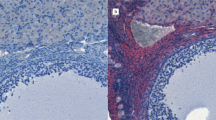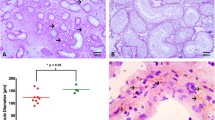Abstract
Since the human appendix testis is a Mullerian duct derivative it has been theorised that rising oestrogen levels in puberty result in enlargement of this organ and consequent predisposition to torsion. This study sought to establish the presence or absence of both androgen and oestrogen receptors in the human appendix testis. Bilateral appendix testis specimens surgically excised from ten patients undergoing scrotal exploration for acute scrotum were stained immunohistochemically for androgen and oestrogen receptors. These were examined by light microscopy. The human appendix testis was found to express both oestrogen and androgen receptors. Marked regional variation of androgen and oestrogen receptor positivity was demonstrated. The surface epithelium and some stromal cells were androgen receptor positive, whereas oestrogen receptors were confined to ductular invaginations, gland-like structures and some stromal cells. Rising levels of androgens and oestrogens in pubertal boys may account for enlargement and the predisposition of the human appendix testis for torsion since this structure contains receptors for both.






Similar content being viewed by others
References
Morgagni G (1761) De Sedibus et Cousis Morborum. Bassano, Padua
Rolnick D, Kawanoue S, Szanto P, Bush IM (1968) Anatomical incidence of testicular appendages. J Urol 100:755–756
Murnaghan GF (1959) The appendages of the testis and epididymis: a short review with case reports. Br J Urol 31:190–195
Sahni D, et al. (1996) Incidence and structure of the appendices testis and epididymis. J Anat 189: 341–348
Klein O, et al. (1996) A longitudinal assessment of hormonal and physical alterations during normal puberty in boys II. Estrogen levels as determined by an ultrasensitive bioassay. J Clin Endocrinol Metab 81:3203–3207
Hutson JM, Beasley SW (1988) The surgical examination of children: an illustrated guide. Heinemann, Oxford, p 42
Skoglund RW, McRoberts JW, Radge H (1970) Torsion of testicular appendages: presentation of 43 new cases and a collective review. J Urol 104:598–600
Veeraghavan K, Cass BP, Cass AS (1982) Torsion of the testis and its appendages. Minn Med 65:337–340
Jones P (1962) Torsion of the testis and its appendages during childhood. Arch Dis Child 37:214–226
Zuckerman S, Krohn PL (1937) The hydatids of Morgagni under normal and experimental conditions. Philos Trans 228:147–164
Dickson RB, Clark CR(1984) Estrogen receptors in the male. Arch Androl 7:205–217
Acknowledgement
Special thanks to Mr Stan Wisniewski of Hollywood Urology, Perth, for arranging the funding for the project.
Author information
Authors and Affiliations
Corresponding author
Rights and permissions
About this article
Cite this article
Samnakay, N., Cohen, R.J., Orford, J. et al. Androgen and oestrogen receptor status of the human appendix testis. Ped Surgery Int 19, 520–524 (2003). https://doi.org/10.1007/s00383-002-0936-7
Accepted:
Published:
Issue Date:
DOI: https://doi.org/10.1007/s00383-002-0936-7




